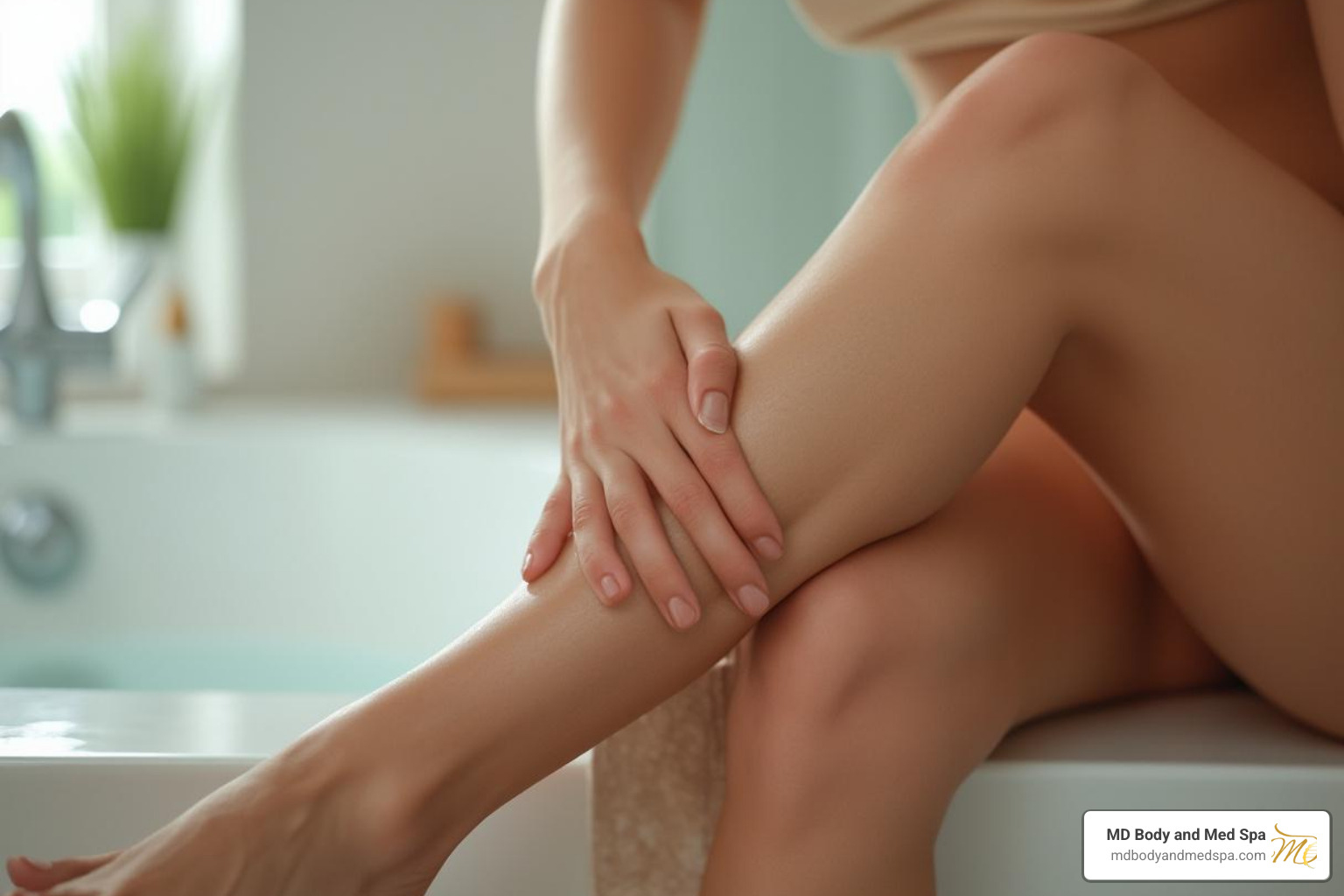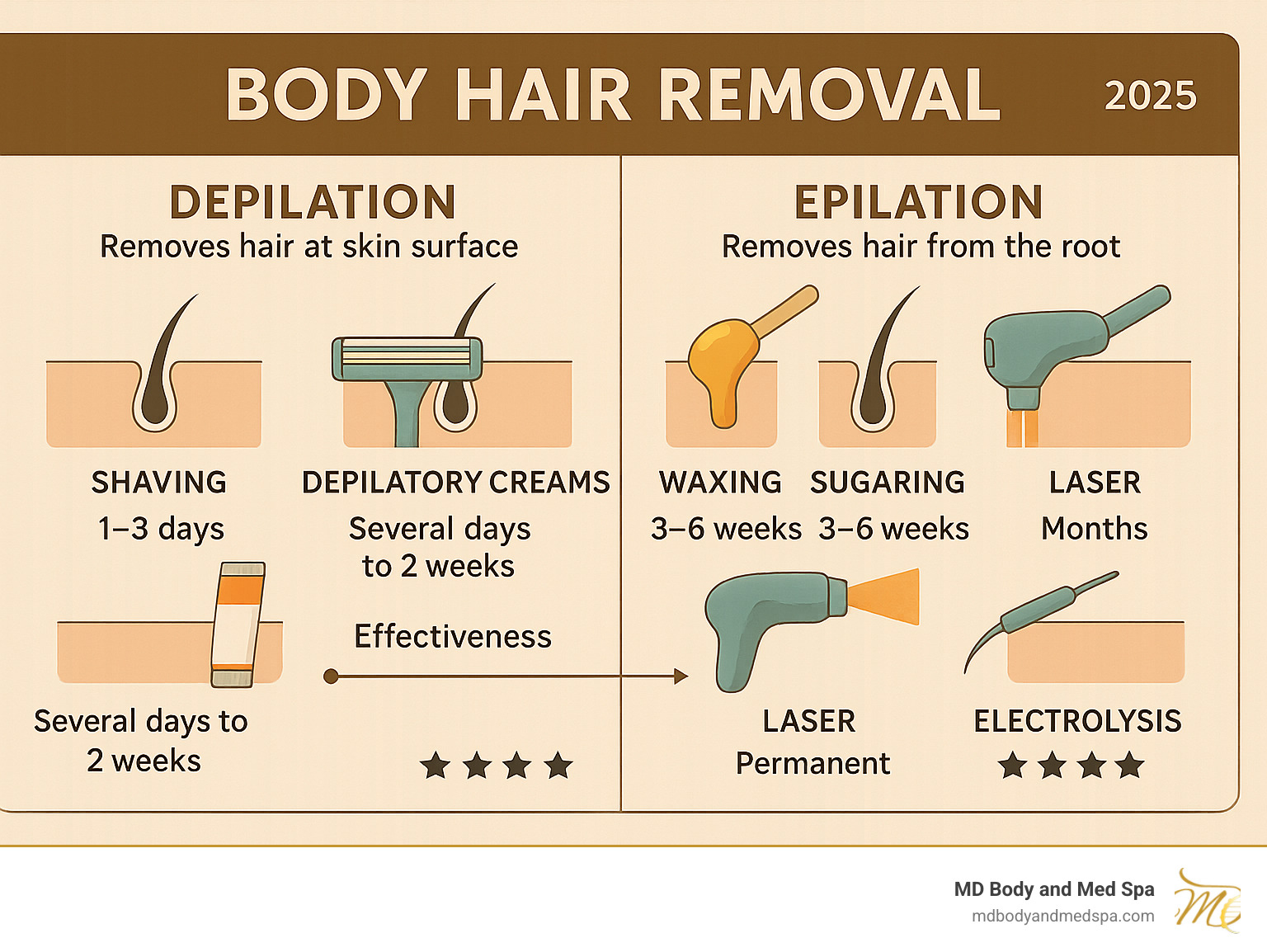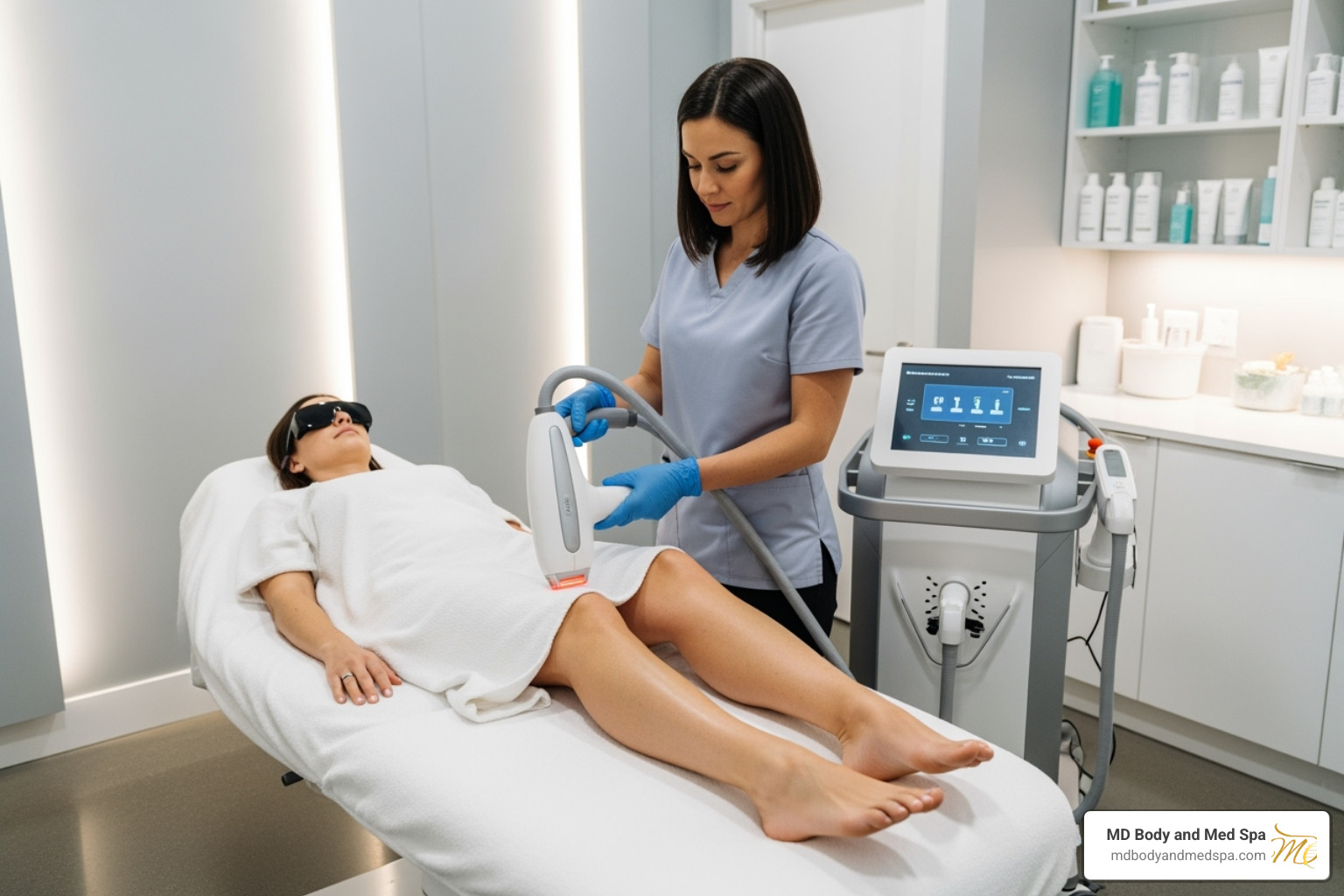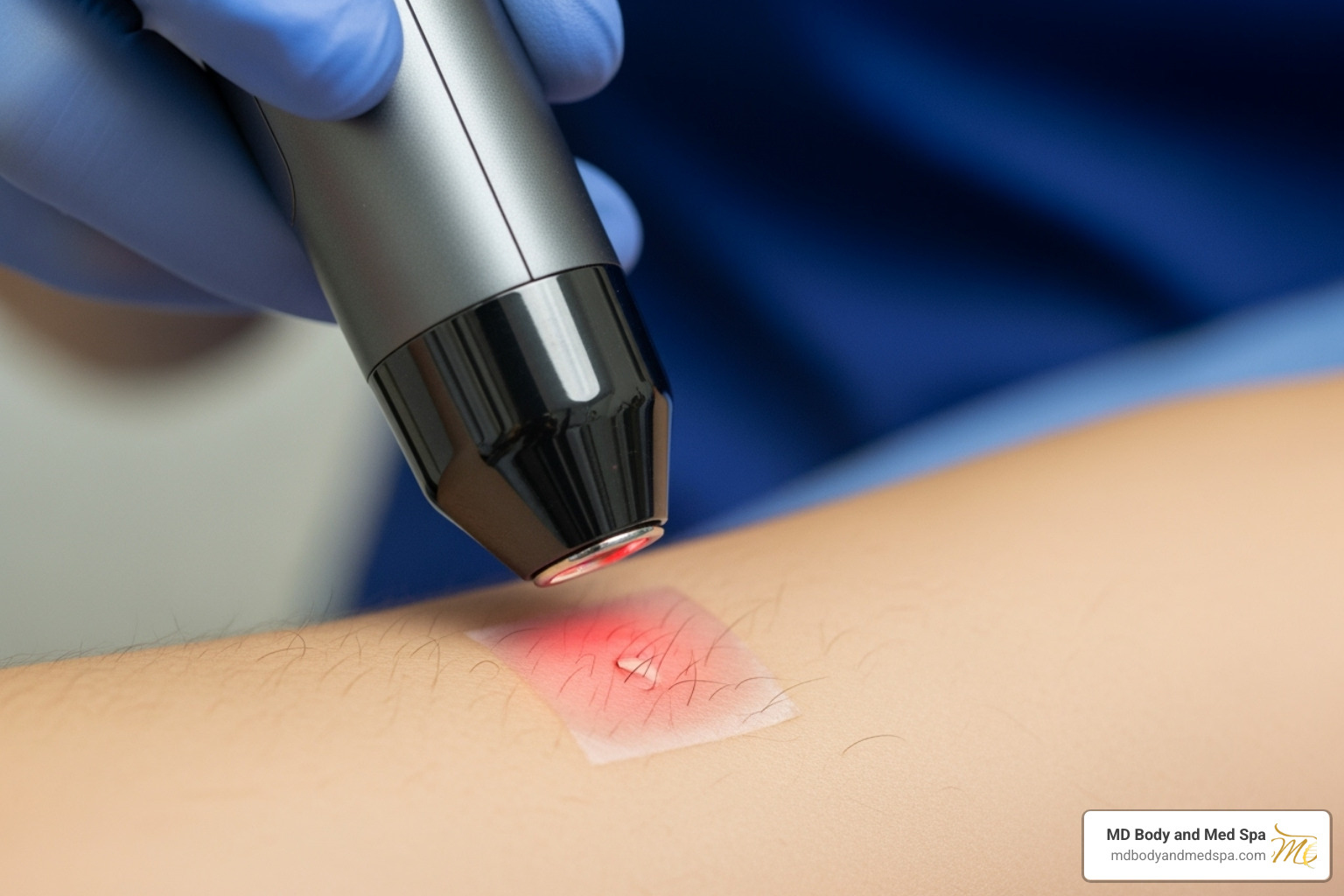Hair Today, Gone Tomorrow: Your Guide to Body Hair Removal
Why Body Hair Removal Remains a Personal Choice

Body hair removal is a practice that spans cultures, centuries, and personal preferences. Whether you're considering shaving, waxing, laser treatments, or other methods, understanding your options helps you make informed decisions about your body.
Quick Overview of Body Hair Removal Methods:
- Temporary Methods: Shaving (1-3 days), waxing (3-6 weeks), depilatory creams (several days to 2 weeks)
- Permanent Reduction: Laser hair removal (6-8 sessions), IPL treatments
- Permanent Removal: Electrolysis (only FDA-approved permanent method)
- Best For: Personal preference - no method is medically necessary for health
The human body naturally grows two types of hair: fine vellus hair (peach fuzz) and coarser terminal hair. Some 30% of women's and 90% of men's bodies are covered with terminal hair, yet personal choice drives whether we keep or remove it.
Depilation removes hair at the skin's surface (like shaving), while epilation removes the entire hair from the root (like waxing or laser treatments). Each approach offers different benefits in terms of results duration and maintenance.
From ancient Egyptian sugar pastes to modern laser technology, hair removal methods have evolved dramatically. Today's options range from quick at-home solutions to professional treatments that can reduce hair growth for months or even permanently.
I'm Rachel Stone, a Certified Laser Technician and Medical Aesthetics specialist. With over a decade of experience, I help clients find body hair removal options that align with their lifestyle and goals, guiding them toward the safest, most effective approach for their unique needs.

Understanding Body Hair and Why We Remove It
The practice of body hair removal dates back to our earliest ancestors. Cave drawings suggest they used sharp flints and shells to remove hair, not just for aesthetics, but for practical reasons like hygiene and comfort.
Throughout history, hair removal has held cultural significance. The Ancient Romans viewed smooth skin as a sign of purity and status. Ancient Egyptians used early forms of sugaring for spiritual cleanliness and grooming. The modern trend toward hairless skin for women gained momentum in the early 20th century, when a 1915 Harper's Bazaar campaign called underarm hair removal a "necessity."
Today, our reasons for body hair removal are a blend of historical influences and modern factors:
- Aesthetics and Comfort: Many people simply prefer the look and feel of smooth skin.
- Hygiene: Removing hair can reduce body odor by preventing sweat and bacteria from accumulating.
- Medical Reasons: Hair is often removed before surgery to reduce infection risk. It's also a key part of managing conditions like hirsutism (excessive hair growth), often linked to PCOS.
- Athletic Performance: Athletes like swimmers and cyclists often remove hair to reduce drag or simplify injury treatment.
- Self-Expression and Culture: For some, hair removal is a form of self-expression, a way to align with their gender identity, or guided by religious or social norms.
- Personal Preference: The choice to remove body hair is deeply personal. At MD Body and Med Spa, we believe it's about what makes you feel confident.
If you're curious about the deeper roots of this practice, we recommend exploring A brief history of hair removal practices.
The Science of Your Hair
Understanding body hair removal starts with the hair itself. Each strand is made of keratin and grows from a hair follicle beneath the skin's surface.
Your body grows two main types of hair:
- Vellus hair: Fine, soft, often colorless "peach fuzz" that covers most of your body and helps regulate temperature.
- Terminal hair: Thicker, coarser, and darker hair on your head, eyebrows, and, after puberty, in areas like the armpits and pubic region. This hair offers cushioning and protection.
Hair grows in a three-phase cycle:
- Anagen (Growth) Phase: The active period when the follicle produces hair.
- Catagen (Transition) Phase: A short phase where growth stops and the follicle shrinks.
- Telogen (Resting) Phase: The follicle rests before the old hair sheds and a new one begins to grow.
Understanding this cycle is crucial for treatments like laser hair removal, which target hair in the active anagen phase.
Temporary Hair Removal: Your At-Home Options

Temporary body hair removal methods are a convenient and budget-friendly starting point. These at-home options fall into two categories: surface removal (like shaving) cuts hair at the skin level for quick results, while root removal (like waxing) pulls the entire hair from the follicle for longer-lasting smoothness. Understanding this difference, along with the pain level and potential side effects of each method, helps you choose the best option for your lifestyle.
Comparing Temporary Body Hair Removal Methods
Shaving cuts hair at the skin's surface with a razor. It's ideal for large areas like legs, armpits, and bikini areas. Results last 1 to 3 days, but potential side effects include nicks, razor burn, and ingrown hairs.
Depilatory creams use chemicals to dissolve hair just below the skin's surface. They are a pain-free option for legs, arms, and bikini areas, with results lasting several days to 2 weeks. Skin irritation, allergic reactions, and a chemical odor are possible side effects.
Tweezing removes individual hairs from the root, making it perfect for small areas like eyebrows or the chin. Results last 3 to 8 weeks, but the process can be painful and may cause redness or ingrown hairs.
Waxing removes multiple hairs from the root at once, effective for legs, bikini areas, underarms, and face. It provides 3 to 6 weeks of smoothness but can be painful and cause redness, bumps, or ingrown hairs. Avoid waxing if you use Retin-A or Accutane, as it can cause skin lifting.
Sugaring uses a natural paste of sugar, lemon, and water to remove hair from the root. It's effective for the same areas as waxing, with results lasting 3 to 6 weeks. Many find it less painful and gentler on sensitive skin, as the paste doesn't stick to live skin cells.
Best Practices for At-Home Hair Removal
To get the best results and avoid irritation, follow these tips:
- Start Clean: Always work on clean skin to prevent infection or folliculitis.
- Exfoliate First: Gently exfoliate a day or two beforehand to prevent ingrown hairs.
- Patch Test: Test new creams or waxes on a small area 24 hours before full use.
- Shave Smart: Shave with the direction of hair growth to reduce irritation and ingrowns. Use a lubricating shave cream.
- Moisturize After: Soothe skin with a good moisturizer after any hair removal method to prevent dryness and itching.
Every person's skin is different, so don't be afraid to experiment safely to find your perfect body hair removal routine. If you're considering more sensitive areas, check out our guide on at-home Brazilian hair removal.
The Path to Permanent Body Hair Removal

For a more lasting solution to body hair removal, professional treatments offer permanent hair reduction or removal. It's crucial to understand the distinction:
- Permanent Hair Reduction: Methods like laser and IPL significantly reduce hair growth (often 85-90%), but don't guarantee 100% removal. The FDA approves laser hair removal for "permanent reduction," and occasional touch-ups may be needed.
- Permanent Hair Removal: Electrolysis is the only method the FDA recognizes as truly permanent. It permanently destroys the hair follicle, preventing regrowth.
These treatments offer long-term freedom from daily maintenance. For a deeper dive, read our article: Is Laser Hair Removal Permanent?.
Electrolysis: The Only Truly Permanent Method
Electrolysis is the only body hair removal method that the FDA calls truly permanent. It's an invaluable option for those seeking complete and irreversible hair removal.
How it works: A technician inserts a fine probe into each hair follicle, delivering an electrical current to destroy it. The main types are Galvanic (chemical), Thermolysis (heat), and the Blend method (both).
Number of sessions: Multiple sessions are required to treat each hair in its growth phase. Total treatment time can range from 4-10 hours for a small area like the upper lip to 8-16 hours for the bikini line, broken into sessions of 15-60 minutes.
Best for small areas: Its hair-by-hair approach makes electrolysis ideal for smaller areas like the eyebrows, upper lip, or chin.
Suitable for all hair colors: Unlike laser, electrolysis works on all hair colors, including blonde, red, gray, and white hair.
Pain sensation: Electrolysis can cause a stinging or pricking sensation, but it is generally tolerable and can be managed with numbing creams.
Laser and IPL for Long-Term Hair Reduction
Laser hair removal and Intense Pulsed Light (IPL) are popular choices for long-term hair reduction.
How they work:
- Laser Hair Removal: A concentrated beam of light targets the melanin (pigment) in hair. The light converts to heat, damaging the follicle to inhibit growth while leaving the surrounding skin unaffected.
- Intense Pulsed Light (IPL): This method uses a broad spectrum of light to heat and damage the follicle. IPL is not a true laser and carries a higher risk of burns on darker skin.
Targeting melanin: These methods work best with high contrast between skin and hair (light skin, dark hair). However, advanced lasers like the Nd:YAG can now safely treat darker skin tones. Laser is ineffective on blonde, red, or white hair, which lacks sufficient melanin.
Number of treatments: Laser hair removal typically requires six to eight treatments, spaced eight to 12 weeks apart, to target hair in its active growth phase.
Effectiveness: Laser hair removal offers "permanent reduction" by disrupting hair production in treated follicles. It is most effective on coarse hair; some fine hair may remain. New growth can occur due to hormonal changes, and paradoxical hair stimulation is a rare risk.
At MD Body and Med Spa, we use the advanced Diolaze laser system, which is fast, powerful, and virtually painless thanks to built-in cooling. It's safe for all skin types, allowing us to provide exceptional results for our clients.
To learn more, visit our pages on More on Laser Hair Removal and Permanent Hair Reduction explained.
Key Considerations for All Hair Removal Methods

Before starting any body hair removal method, safety and suitability are key. There is no one-size-fits-all approach; your skin tone, hair color, and medical history all determine which methods are safe and effective for you. Understanding these factors prevents poor results and potential harm.
How Skin and Hair Type Affect Your Results
The Fitzpatrick scale, which classifies skin's reaction to sun, helps determine treatment safety. A laser that works for fair skin may be unsafe for darker skin.
Lighter skin tones often see the best results with laser hair removal. The high contrast between dark hair and light skin allows the laser to target the hair's melanin effectively without harming the skin.
Darker skin tones require specific lasers, like the Nd:YAG, which use longer wavelengths to bypass melanin in the skin and prevent burns. IPL treatments are riskier for darker skin.
Hair color and texture are also critical. Laser targets dark pigment (melanin), so it works well on dark, coarse hair but is ineffective on blonde, red, gray, or white hair. For light-colored hair, electrolysis is the best permanent option. Coarse hair responds well to lasers, while fine hair can be stubborn and may require follow-up electrolysis.
If you have concerns, I recommend our guide on At-Home Laser Hair Removal for Dark Skin considerations. For any medical concerns, it's wise to Consult a board-certified dermatologist before starting any treatment plan.
Prescription and Medical Hair Removal Options
Excessive hair growth can be a medical condition like hirsutism (male-pattern hair growth in women), often linked to polycystic ovary syndrome (PCOS) or hormonal imbalances. In these cases, prescription treatments can be combined with traditional body hair removal.
Eflornithine hydrochloride cream (Vaniqa) is a topical prescription that slows facial hair growth in women by blocking a key enzyme. It's applied twice daily, with results in 4-8 weeks, but must be used continuously alongside other removal methods.
Spironolactone is an oral anti-androgen medication that blocks male hormones responsible for excess hair growth. It's prescribed for hirsutism and used in hormone therapy for transgender women. Results take about six months and require medical monitoring.
Both treatments require a doctor's prescription and are not suitable for pregnant or breastfeeding women. At MD Body and Med Spa, we always start with a thorough consultation to understand your medical history and goals before recommending any treatment plan.
Frequently Asked Questions about Body Hair Removal
We hear the same questions about body hair removal over and over again at MD Body and Med Spa. Let's tackle the most common myths and concerns.
Does shaving make hair grow back thicker or darker?
No, this is a common myth. Shaving does not change your hair's thickness, color, or growth rate. When you shave, you cut the hair at the surface, creating a blunt tip. This blunt end feels coarse and stubbly as it grows out, which creates the illusion of thicker hair. Your hair's characteristics are determined by genetics and hormones, not your razor.
Is professional hair removal painful?
Pain tolerance is subjective, but we can provide a general guide.
- Laser hair removal is often described as a quick rubber band snap against the skin. Advanced systems like our Diolaze laser have built-in cooling to maximize comfort.
- Electrolysis can feel like a stinging or pricking sensation with each treated hair.
Modern techniques and topical numbing creams make professional body hair removal far more comfortable than in the past. Most clients find the sensation manageable, especially considering the long-term results. If you're considering treatment for sensitive areas, you might find our article helpful: More on Brazilian Laser Removal comfort.
How much does professional hair removal cost?
The cost of professional body hair removal depends on the method, treatment area size, and location.
- Electrolysis is usually priced by time (e.g., per 15- or 30-minute session).
- Laser hair removal is typically priced per session or as a package deal, which is often more cost-effective.
Larger areas like the legs or back will cost more than smaller areas like the upper lip. Both methods require multiple sessions for best results. We recommend a consultation for a personalized quote. For more detailed pricing information, check out our guide: See typical laser hair removal costs.
Your Journey to Smooth Skin
Your body hair removal journey is uniquely yours. There's no "right" or "wrong" choice – only what works best for your lifestyle, comfort level, and goals. You can combine different approaches, like shaving for quick touch-ups and professional treatments for areas you want to address long-term. What matters most is making informed decisions based on accurate information, not myths or pressure from others. Your body, your choice.
Professional consultation is invaluable when considering permanent options. A qualified provider can assess your skin, hair, and goals to recommend the most effective approach.
At MD Body and Med Spa, we guide you through the process of choosing the right body hair removal method. Serving Greenwood Village and the greater Denver area, we combine expertise with the latest technology to create personalized treatment plans. Our goal is to help you feel confident and comfortable in your skin, safely and effectively.
Ready to explore your options? Explore our professional laser treatments and let our team help you achieve the smooth skin you desire.
